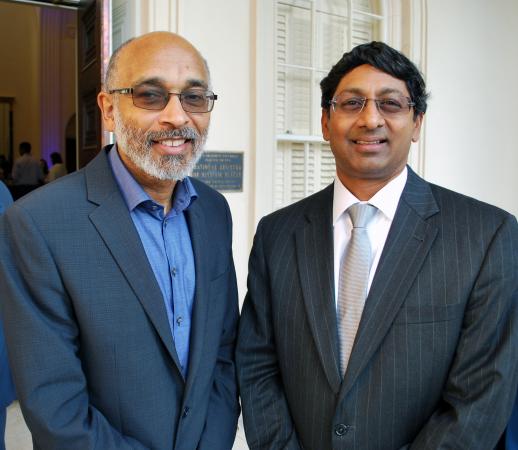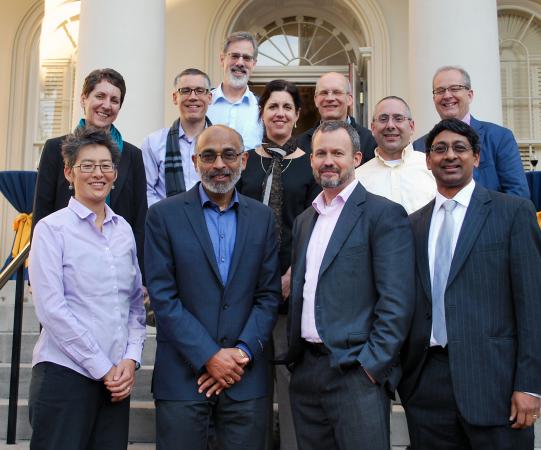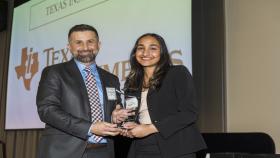Emery Brown may be forgiven if he sometimes feels as if he’s collaborating with himself, combining two seemingly disparate disciplines in an effort to know more about the human brain.
Brown, who is an anesthesiologist and a statistician, affiliated with both the Massachusetts Institute of Technology and Harvard University, brought all of it together recently when he delivered the annual Wallace H. Coulter Distinguished Lecture in Biomedical Engineering (BME).
“How many people have had anesthesia before?” Brown asked his audience of more than 130 at the Academy of Medicine at the outset of his lecture, entitled, “Deciphering the Dynamics of the Unconscious Brain Under General Anesthesia.”
When about half the people in the room raised their hands, he said, “well, I picked the right topic then.”
Then he spent the next 45 minutes or so presenting his research on what happens to the human brain, at different ages, under anesthesia. Sorting it all out, he said, required “an amalgam of neuroscience, statistics and modeling.”
The work represents an important contribution to neuroscience because historically, “we haven’t taken the study of general anesthesia seriously as a neuroscience discipline, and it very much is,” he said, adding that a more serious approach to studying anesthesiology will not only improve patient care, but lead to a greater understanding of how the brain works and help address other problems in clinical neuroscience.
Along the way, Brown also helped answer another, broader question for Coulter Department Chairman Ravi Bellamkonda.
“People ask me all the time, ‘what do biomedical engineers do,’” said Bellamkonda, who had earlier described the BME department as, “a powerful incubator of ideas.”
Brown’s presentation, he said, was a great example of how different disciplines help spark the knowledge and discovery that keeps the incubator humming with activity. “This talk was a perfect illustration of how technology and math and physics can help us understand something that we think of as biology,” Bellamkonda added.
This year’s lecture provided an opportunity for BME’s growing expertise in neuroscience to step to the forefront, said Garrett Stanley, the BME professor who served as faculty host, and who first met Brown years ago.
At the time, Stanley was just starting his lab at Harvard and a colleague suggested he seek out Brown for some statistical information. Stanley was surprised to discover that Brown was also an anesthesiologist.
“But he was also a serious statistician and mathematician, immersed in the field of neuroscience,” Stanley said. “I’m not a scholar in etymology, but I’m pretty sure that the two words ‘anesthesiologist’ and ‘statistician’ have probably never been concatenated in the history of the English language. I think we can thank Emery for that.”
For his part, Brown took note of the collaborative, multi-disciplinary approach being taken in general at the Georgia Institute of Technology, and specifically within the Coulter Department, a joint department of Georgia Tech and Emory.
“The work here is phenomenal,” he said. “This beautiful integration of medicine and engineering and science, because you’ve brought together two institutions, Georgia Tech and Emory. It’s unique, and the possibilities are boundless.”
CONTACT:
Jerry Grillo
Communications Officer II
Parker H. Petit Institute for
Bioengineering and Bioscience
Media Contact
Jerry Grillo
Communications Officer II
Parker H. Petit Institute for
Bioengineering and Bioscience
Keywords
Latest BME News
Jo honored for his impact on science and mentorship
The department rises to the top in biomedical engineering programs for undergraduate education.
Commercialization program in Coulter BME announces project teams who will receive support to get their research to market.
Courses in the Wallace H. Coulter Department of Biomedical Engineering are being reformatted to incorporate AI and machine learning so students are prepared for a data-driven biotech sector.
Influenced by her mother's journey in engineering, Sriya Surapaneni hopes to inspire other young women in the field.
Coulter BME Professor Earns Tenure, Eyes Future of Innovation in Health and Medicine
The grant will fund the development of cutting-edge technology that could detect colorectal cancer through a simple breath test
The surgical support device landed Coulter BME its 4th consecutive win for the College of Engineering competition.









